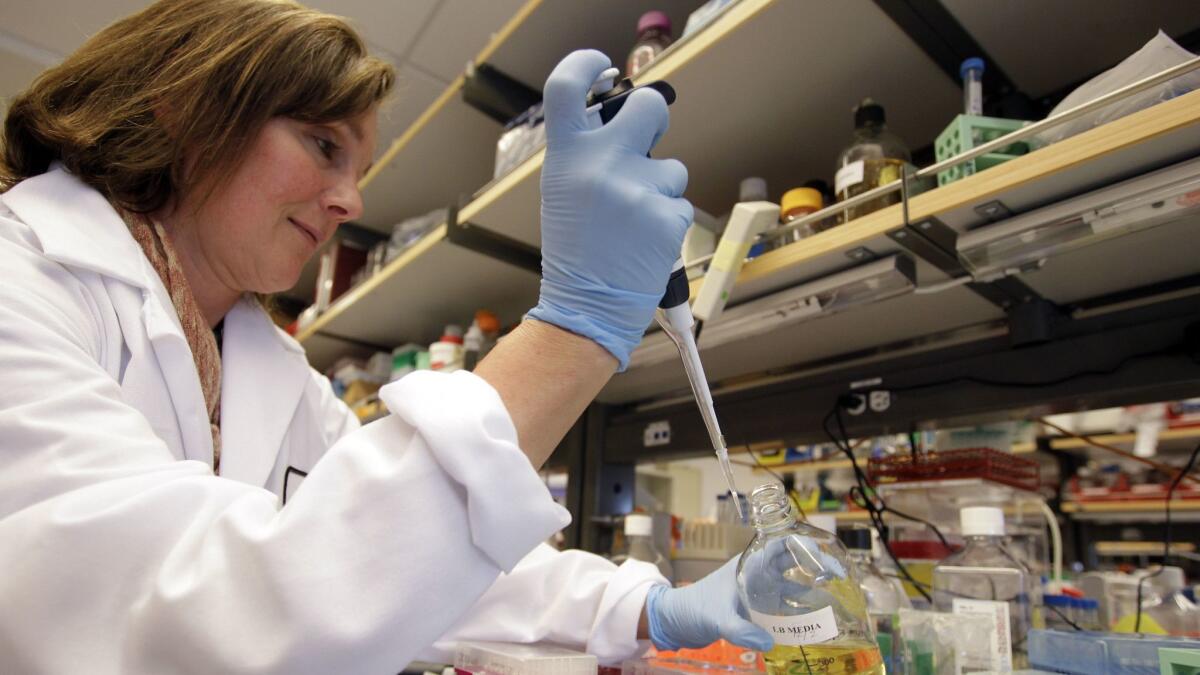Column: California’s stem cell program faces an existential moment — and a chance for reform

- Share via
The $6-billion California stem cell program, created at the ballot box in 2004, is about to notch a major achievement.
A stem cell-based cure developed by a team at UCLA for a rare disease — a “bubble baby” disease that deprives children of a functioning immune system — is on a path toward expected approval by the Food and Drug Administration as early as next year. It would be the first treatment funded by the program to reach the market.
But the California Institute for Regenerative Medicine (CIRM), the program’s official name, also is facing an existential inflection point. By the end of this year, the program expects to allocate the last of the $3 billion in state bond funds ($6 billion with interest) that voters approved in 2004.
We can’t say we’ve cured cancer or diabetes, but we have made dramatic progress.... Anything we do is going to be transformative for those affected.
— CIRM Chairman Jonathan Thomas
The program’s leadership and its principal backer, investment executive Robert Klein II, are planning an initiative campaign to ask voters in November 2020 for an additional $5.5 billion, plus interest. This would be Klein’s second initiative campaign in the field — he drafted Proposition 71, the 2004 ballot measure and served as CIRM’s first chairman. Thus far, his work is progressing behind closed doors. He didn’t respond to my requests for an interview.
CIRM has funded 54 clinical trials of potential disease treatments, of which 42 are currently active. CIRM provides the major financial support for most of these projects, according to its chairman, Jonathan Thomas. Without the new funding, Thomas told me, “a great percentage of those projects would hit the wall. That would set the field of cellular therapy and regenerative medicine back tremendously.”
CIRM has had its administrative ups and downs, but its importance as a player in advancing a difficult and complex science is manifest. So is the wisdom of giving the program a new lease on life through new public funding.
The program has fulfilled its fundamental goal of turning California into a mecca of advanced genetic and regenerative research. “California is the place to be if you want to develop stem cell treatments,” Jeanne Loring of Scripps Research Institute in La Jolla, who has received several million dollars in CIRM grants to research possible treatments for Parkinson’s disease, told me some time ago. “A lot of my colleagues in other states are envious.”
CIRM sees its mission as unique in the biological sciences. Its huge war chest has allowed it to support research projects during a speculative phase in which researchers need funding but traditional investors, even venture investors with an appetite for risk, are wary of putting up any money. Stem cells are undifferentiated cells that can turn into specialized cells as the body needs them, if researchers can train them to replace damaged cells in the form and place they’re needed.
“Investors aren’t willing to come in too early,” CIRM President Maria Millan says. “So CIRM continues to play an extremely important role of boldly investing early and de-risking these programs” so they can reach the point of attracting outside commercial investors. “We need to do more of this.”
Balancing the political realities of initiative campaigns with scientific reality, however, is a challenge — and one that the 2004 campaign for Proposition 71 handled atrociously. Whether Klein and his fellow promoters will do anything differently in the next initiative campaign is a key question.
The backers of Proposition 71 plied the public with flagrantly irresponsible promises of “cures” for conditions such as Parkinson’s, Alzheimer’s and spinal cord injuries. They made inflated forecasts of the financial returns from research and denigrated the taxpayers’ elected legislative representatives as enemies to be locked out of the oversight loop.
Some of these attributes could become issues in the next initiative campaign, to the program’s disadvantage.
Proposition 71 mandated that CIRM’s governing board comprise almost exclusively officials of California universities, other research institutions, patient advocacy groups and executives of biotech firms, most of which are eligible for financial support from the program. This resulted, according to a 2012 study by the National Academy of Sciences, in “almost unavoidable conflicts of interest, whether actual or perceived.”
Thomas says that the board members are subject to “extremely stringent conflict-of-interest rules” and that “no board member has ever had an instance of a conflict on any funding decision.”
But there certainly have been close calls. In 2007 board member John C. Reed tried to get CIRM’s staff to reverse the rejection of a grant for the La Jolla-based Burnham Institute for Medical Research (now the Sanford Burnham Prebys Institute), of which he was chief executive. The staff refused. Reed got his wrist slapped by state ethics officials and remained on the board until 2010.
In 2012, the board approved a $20-million funding award to Stem Cells Inc. for an Alzheimer’s project, despite its rejection by CIRM’s scientific reviewers but at the urging of Klein, who was no longer chairman but still wielded outsize influence at CIRM.
The insularity of a CIRM leadership dominated by insiders in the state’s research community doesn’t raise concerns only about conflicts but also about the diversity of opinion on the board. Monoculture is never healthy, whether we’re talking about nonprofit boards or natural ecosystems. Given that CIRM, uniquely among state entities, also is almost totally exempt from legislative oversight, the tendency for its 29 board members all to see things the same way can only be intensified.
Another worrisome element is the propensity of backers to promise unreasonable results, such as disease “cures.” Klein appears to be going down that road again — the advocacy group he created to advance his new initiative is named “Americans for Cures”.
The next initiative campaign may have to answer voters’ questions about why there haven’t actually been any cures, 15 years after Proposition 71’s enactment. Answering those questions would be easier if the promoters could say that they never promised “cures.” But the promise is etched right there in the title of the initiative, the California Stem Cell Research and Cures Act.
Thomas acknowledges that “science is a nuanced series of progressions and it takes time for things to play out…. We can’t say we’ve cured cancer or diabetes, but we have made dramatic progress.” He points to the impending FDA ruling on the “bubble baby” treatment.
Still, the Proposition 71 publicity juggernaut led voters to believe that lack of money was the chief obstacle to finding cures for headline conditions such as Parkinson’s and Alzheimer’s — when the truth is that such neurological conditions are the most difficult for medical science to crack.
One almost senses a fear in the CIRM community that the public won’t be sufficiently jazzed by scientific efforts that fall short of “moonshots,” to use an Obama administration term. “We’re going after cures, not chronic treatments,” Thomas told me. “Anything we do is going to be utterly transformative for those affected by a particular condition and their families.”
Yet there’s nothing shameful about aiming for an intermediate benchmark; a new chronic treatment surely can be transformative for sufferers of an intractable disease. If the fits-and-starts reality of medical progress were presented candidly to California voters, who’s to say they wouldn’t accept CIRM’s role in that timeline with pride?
The prospect of a new initiative offers the opportunity to reconsider CIRM’s structure and mission.
Proposition 71 paid lip service, indirectly, to concerns that the cost of medical treatment is moving beyond the reach of most families. But it offered no mechanism to guarantee Californians access to treatments developed with public funds or even to provide discounts to California healthcare programs. Access is bound to become an ever-greater issue, for gene therapies that resemble projects funded by CIRM are reaching market with price tags in the hundreds of thousands of dollars; the most expensive new drug approved by the FDA, a treatment for a rare wasting disease in infants, will cost $2.1 million for a one-time dose.
Klein told David Jensen of the California Stem Cell Report that he is contemplating a provision in the next initiative for “funding the infrastructure to work on access, to work with insurance companies, to work with Covered California, to work with Medicare, to make sure that there’s access, to make certain that public hospitals and public clinics in California get discounted prices.” That would be worthwhile, if it can be done.
There is also an urgent need for generalized training in regenerative science for medical students and physicians. “So much of this work is right at the cutting edge,” says Paul Knoepfler, a UC Davis stem cell biologist who is a CIRM grantee. “We’re really at the point where there are a lot of complex issues that relate to the work that CIRM is funding.” If CIRM wins funding to carry it through another decade, he says, “there are definitely going to be more challenging ethical issues and other things that could be addressed by training.”
How CIRM’s bid for $5.5 billion in new funding will fare politically in 2020 is impossible to gauge just yet, especially in the absence of a concrete proposal. But the campaign’s best friend could be Donald Trump.
The scientifically ignorant constraints George W. Bush had placed on stem cell research may well have been decisive in persuading California voters in 2004 to fund a landmark program to fill the gap. (The Obama administration overturned the Bush regulations.) The Trump administration’s open hostility to scientific research could perform the same service in 2020. California has stood up against Trump in many ways; encouraging science fits into this theme.
But confidence in the rectitude of their scientific mission shouldn’t embolden CIRM’s backers to go down the same deceptive path they traveled in 2004.
California’s stem cell program has proved its value to the state and to science. It has earned the opportunity to show what it can achieve with an additional 10 years of life and billions more.
But Californians also have earned the right to a program that is more accountable to legislative oversight and subject to more diverse viewpoints on its board. These are changes that can be made in CIRM’s structure without compromising by one iota its access to technical and scientific expertise.
Voters also have earned the right to an honest accounting of the challenges inherent in bringing stem cell and gene-based disease treatments to fruition. CIRM gains nothing from minimizing the difficulty and complexity of its science. If its backers offer a candid picture of these challenges, the path ahead will be exciting. If they repeat the exploitative promises of cures and riches from 2004, what lies ahead will be disappointment.
Keep up to date with Michael Hiltzik. Follow @hiltzikm on Twitter, see his Facebook page, or email [email protected].
Return to Michael Hiltzik’s blog.
More to Read
Inside the business of entertainment
The Wide Shot brings you news, analysis and insights on everything from streaming wars to production — and what it all means for the future.
You may occasionally receive promotional content from the Los Angeles Times.











